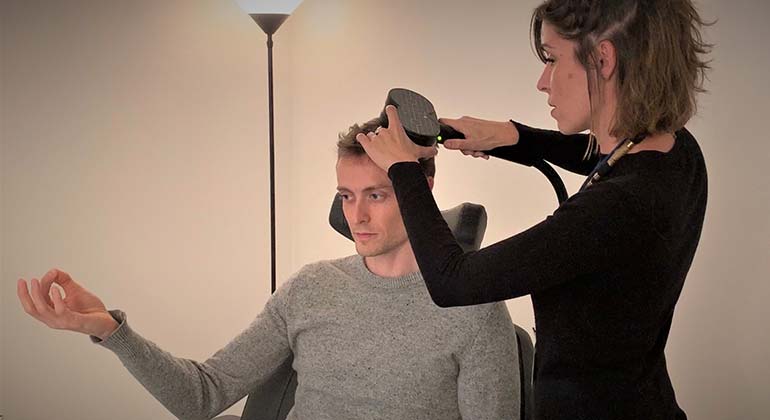
Noninvasive Brain Stimulation Program
One of the few programs of its kind in the nation, our noninvasive brain stimulation (NIBS) program at the Abilities Research Center (ARC) is run by neurologic rehabilitation experts with more than 10 years of experience in NIBS. Our team provides various brain stimulation techniques coordinated with evidence-based rehabilitation approaches to treat a range of movement disorders and neurological conditions.
When Can NIBS Help?
The therapeutic value of brain stimulation is recognized by a range of medical fields. Our program uses NIBS to help improve various brain functions in patients with conditions that include:
- Spinal cord injury
- Stroke
- Traumatic brain injury
- Parkinson’s disease
- Cancer
In addition, we have found that NIBS can be helpful for patients with other conditions, such as:
- Chronic neuropathic pain
- Language and communication disorders (aphasia)
- Uncontrolled muscle movement (spasticity)
How Does NIBS Work?
Used worldwide, noninvasive brain stimulation is safe, painless, and causes very few side effects. The goals of NIBS include maximizing quality of life; minimizing chronic neuropathic pain; and lessening the impact that neurologic conditions may have on functional areas such as cognition, movement, uncontrolled muscle movement (spasticity), and speaking.
NIBS can be performed in one of two ways. The procedure can either stimulate a damaged area of the brain with the goal of restoring its function, or it can compensate for the damaged area’s loss of function by stimulating another area.
NIBS Technologies
Our team understands every patient is different, so our specialists rely on information gathered during your evaluation to determine how NIBS may be used to help you. For the purposes of rehabilitation, our team may choose one or both of the following NIBS technologies:
- Transcranial magnetic stimulation: This technique uses a special coil to generate a magnetic pulse that stimulates areas of the brain. When the coil is placed over your head, you will hear a “click” and might notice a pulling sensation on the skin. Patients typically describe the sensation as a tapping feeling.
- Transcranial direct current stimulation: This technique involves positioning two small electrodes, which give off weak electrical currents, on a person’s head. Patients may see brief light flashes, and may feel nothing or notice tingling or itching under the electrodes.
Depending on your condition, these brain stimulation techniques often work best when they are coordinated with rehabilitation therapy. A NIBS procedure lasts approximately 20 minutes. We typically pair this treatment with occupational therapy, physical therapy, or speech-language therapy. A common treatment regimen provides high-intensity rehabilitation training in 15 sessions or more spaced over multiple weeks.
How to Participate in Our NIBS Program
If you are interested in brain stimulation, speak with your physician, who can refer you to our program. You may also contact us directly at 212-824-8369 or abilitiesresearchcenter@mountsinai.org. In order to determine whether brain stimulation is right for you, the ARC begins your care with a comprehensive evaluation.
Who Cannot Participate in This Program?
Patients affected by the following conditions or circumstances may not be candidates for NIBS:
- Metallic objects in or near the head
- Implanted stimulator devices in or near the head
- Worsening depression or suicidality
- Medical devices containing electronics or ferromagnetic material
- Implants controlled by physiologic signals
- History (or family history) of seizure or epilepsy
- History of severe headaches or unexplained seizures
- Concurrent medication use such as tricyclic antidepressants, antipsychotic medications, or other drugs known to make you more prone to seizures
- Pregnancy or nursing